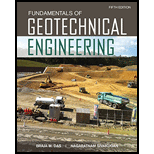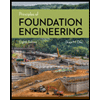
Concept explainers
(a)
Find the net allowable point bearing capacity of the drilled shaft
(a)
Answer to Problem 19.11CTP
The net allowable point bearing capacity of the drilled shaft is
Explanation of Solution
Given information:
The diameter of shaft
The base diameter
The length of the drilled shaft in clay layer 1
The length of the drilled shaft in clay layer 2
The total length of the drilled shaft L is 10.75 m
The unit weight of clay layer 1
The unit weight of clay layer 2
The soil friction angle
The soil friction angle of clay layer 2
The factor of safety FOS is 4.
Calculation:
Find the area of the drilled shat in the clay layer 1
Substitute 1.50 m for
Calculate the value of ratio
Substitute 10.75 m for L and 1.50 m for
Calculate the vertical effective stress
Substitute
Calculate the value of bearing capacity factor
Substitute
Calculate the net load-carrying capacity at the base of the drilled shaft
Get the value of correction factor,
Take the value of correction factor as 0.82.
Substitute
Find the soil-pile friction-angle
Substitute
Calculate the earth pressure coefficient
Substitute
Calculate the perimeter p of the pile using the formula:
Substitute 0.75 m for
Find the critical depth of the drilled shaft
Substitute 0.75 m for
The critical depth of the drilled shaft more than the length of the entire shaft, therefore, the frictional resistance along the pile shaft will increase over the entire length of the shaft.
Consider 0 ft from top of the pile.
Calculate the magnitude of unit frictional resistance,
Substitute 0 m for z.
The frictional resistance (skin friction),
Consider the pile to the depth of 10 m (critical depth of the pile) from the top of pile tip.
Calculate the magnitude of unit frictional resistance,
Substitute 10 m for z, 0.470 for K,
Find the frictional resistance (skin friction),
Substitute 2.36 m for p, 10 m for
Calculate the net allowable point bearing capacity of the drilled shaft using the formula:
Substitute 252.64 kN for
Thus, the net allowable point bearing capacity of the drilled shaft is
(b)
Find the allowable load carrying capacity of the pile
(b)
Answer to Problem 19.11CTP
The allowable load carrying capacity of the pile is
Explanation of Solution
Calculation:
Find the ratio of allowable settlement to the diameter of the base using the relation:
Refer Table (19.6), “Normalized Base loading transfer with settlement for cohesionless soils (based on average curve)” in the text book.
Based on the ratio of allowable settlement to the diameter of the base, take the value of end bearing
Find the allowable load
Substitute 50,096.22 kN for
Find the ratio of allowable settlement to the diameter of the shaft base using the relation:
Refer Table (19.5), “Normalized side load transfer with settlement for cohesionless soils (based on average curve)” in the text book.
Based on the ratio of allowable settlement to the diameter of the shaft base, take the value of
Find the allowable load
Substitute 252.64 kN for
Find the allowable load
Substitute 16,031 kN for
Thus, the allowable load carrying capacity of the pile is
Want to see more full solutions like this?
Chapter 19 Solutions
Fundamentals of Geotechnical Engineering (MindTap Course List)
- For the drilled shaft described in Problem 19.7, estimate the total elastic settlement at working load. Use Eqs. (18.45), (18.47), and (18.48). Assume that Ep = 20 106 kN/m2, s = 0.3, Es = 12 103 kN/m2, = 0.65 and Cp = 0.03. Assume 80% mobilization of skin resistance at working load. (See Part c of Problem 19.7) 19.7 Figure 19.16 shows a drilled shaft without a bell. Here, L1 = 6 m, L2 = 7 m, Ds = 1.5 m, cu(1) = 50 kN/m2, and cu(2) = 75 kN/m2. Find these values: a. The net ultimate point bearing capacity. Use Eqs. (19.23) and (19.24) b. The ultimate skin resistance. Use Eqs. (19.26) and (19.28) c. The working load, Qw (FS = 3) FIG. 19.16arrow_forwardA free-headed drilled shaft is shown in Figure P13.10. Let Qg = 260 kN, Mg = 0, = 17.5 kN/m3, = 35, c' = 0, and Ep = 22 106 kN/m2. Determine a. The ground line deflection, xo b. The maximum bending moment in the drilled shaft c. The maximum tensile stress in the shaft d. The minimum penetration of the shaft needed for this analysisarrow_forwardFor the drilled shaft described in Problem 19.7, determine these values: a. The ultimate load-carrying capacity b. The load-carrying capacity for a settlement of 25 mm Use the procedure outlined in Section 19.8. 19.7 Figure 19.16 shows a drilled shaft without a bell. Here, L1 = 6 m, L2 = 7 m, Ds = 1.5 m, cu(1) = 50 kN/m2, and cu(2) = 75 kN/m2. Find these values: a. The net ultimate point bearing capacity. Use Eqs. (19.23) and (19.24) b. The ultimate skin resistance. Use Eqs. (19.26) and (19.28) c. The working load, Qw (FS = 3) FIG. 19.16arrow_forward
- Figure P13.9 shows a drilled shaft extending into clay shale. Given: qu (clay shale) = 1.81 MN/m2. Considering the socket to be rough, estimate the allowable load-carrying capacity of the drilled shaft. Use FS = 4. Use the Zhang and Einstein procedure.arrow_forwardFor the same data given in Problem 13.4, determine the load-carrying capacity of the drilled shaft, limiting the settlement to 10.0 mm. 13.4 Determine the ultimate load-carrying capacity of the drilled shaft shown in Figure P13.4, using the Reese and ONeill (1989) method.arrow_forwardDetermine the ultimate load-carrying capacity of the drilled shaft shown in Figure P13.4, using the Reese and ONeill (1989) method.arrow_forward
 Fundamentals of Geotechnical Engineering (MindTap...Civil EngineeringISBN:9781305635180Author:Braja M. Das, Nagaratnam SivakuganPublisher:Cengage Learning
Fundamentals of Geotechnical Engineering (MindTap...Civil EngineeringISBN:9781305635180Author:Braja M. Das, Nagaratnam SivakuganPublisher:Cengage Learning Principles of Foundation Engineering (MindTap Cou...Civil EngineeringISBN:9781337705028Author:Braja M. Das, Nagaratnam SivakuganPublisher:Cengage Learning
Principles of Foundation Engineering (MindTap Cou...Civil EngineeringISBN:9781337705028Author:Braja M. Das, Nagaratnam SivakuganPublisher:Cengage Learning Principles of Foundation Engineering (MindTap Cou...Civil EngineeringISBN:9781305081550Author:Braja M. DasPublisher:Cengage Learning
Principles of Foundation Engineering (MindTap Cou...Civil EngineeringISBN:9781305081550Author:Braja M. DasPublisher:Cengage Learning Principles of Geotechnical Engineering (MindTap C...Civil EngineeringISBN:9781305970939Author:Braja M. Das, Khaled SobhanPublisher:Cengage Learning
Principles of Geotechnical Engineering (MindTap C...Civil EngineeringISBN:9781305970939Author:Braja M. Das, Khaled SobhanPublisher:Cengage Learning



